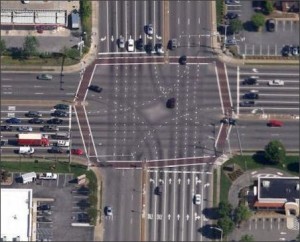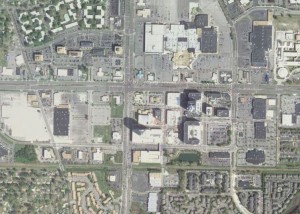by James A. Bacon
Back in the pre-PowerPoint days when people used slide projectors, New Urbanist evangelist Andres Duany traveled around the country with a carousel of slides to illustrate the horrors that poor planning had inflicted upon the urban landscape. One of those slides, I recall, was an aerial shot of the intersection of Independence Boulevard and Virginia Beach Boulevard where 22 lanes (11 for each road, by my count) collided in a jumble of lanes. Making matters worse, the buildings on all corners were surrounded by acres of parking lots. It was a classic case of planning dedicated to the “care and feeding of automobiles,” in Duany’s phrase, that created terrain utterly inhospitable to walking. It made quite an impression upon me that one of the nation’s leading architects had singled out a corner of my home state as a paragon of poor planning.
But times change, and a group of architects, property owners and businessmen have spent the past two decades extricating the so-called Pembroke area of Virginia Beach from the clutches of auto-centric design. To date, they have carved out a walkable, mixed-use district of nine or 10 blocks, designated Town Center. The goal always has been to expand from this nucleus into neighboring blocks, with a vision of creating an urban “downtown” for Virginia Beach, which, outside the resort area, is as shapeless and formless as an amoeba.
So, it comes as encouraging news that the City of Virginia Beach, presumably after long and bureaucratic deliberation, is on the verge of implementing new zoning regulations for the CBD. As Gabriella Souza describes the thrust of the new zoning regs for the Virginian-Pilot:
Shops and restaurants should sit close to the street. Signs should convey an urban ambiance. And don’t even think about constructing buildings with windowless, blank walls. … The goal is to encourage more urban development in the area, to move away from strip malls and parking lots.
Think more walkable areas, public art and buildings that rise up rather than sprawl outward, said city planner Ashby Moss.
City staff will make a presentation about the updated zoning regulations at a public hearing tonight. Judging from the comments under the article, there is a lot of hostility to the idea. As one resident commented:
If you look to the south you can catch a glimpse of the used car lot and garage that is the iconic entrance to Town Center. Or if you prefer, look north and see the historic site (now a parking lot) where the famed Beacon building once stood. Each of these debacles cost the taxpayers $5 million. You’ve got to love that “vision” thing. … You really can’t make this stuff up.
Density is bad, developers are greed-heads, City Hall is squandering tax dollars, etc. Clearly, city officials and the CBD business leaders have a major public relations challenge overcoming the Not In My Back Yard syndrome. In response, I would emphasize a couple of points:
- If you don’t like the idea of living in a compact urban environment, then don’t. Nobody’s making you move there. But other people want to partake in walkable urbanism. Who the hell are you to deprive them of that choice?
- Compact, mixed-use development creates five to ten times more revenue-per-acre than conventional suburban subdivisions and shopping centers — but they actually cost less per acre to maintain and provide with city services. Properly done, mixed-use development can augment the tax base and reduce the pressure for higher taxes.
- Mixed-use development can support mass transit such as buses and, possibly, an extension of the Tide light rail line. The more people who live and work within walking distance of the station, the more people who will use it… and pay fares… and reduce the rail line’s operating costs. When more people walk and ride transit, there are fewer people clogging the roads.
I would side with the anti-urbanism populists on one issue: City policy could generate windfall profits for wealthy landowners. If the city decides to extend the Tide as far as Pembroke, and if it decides to increase development densities there, then land owners will see a surge in property values that they did nothing (other than lobby legislators) to create. To help finance the rail line, the city should set up a Community Development Authority within a 1/4-mile walking radius of the station, taxing property owners to help pay back the bonds used to finance the rail project. Perhaps a formula could be devised so that the tax would vary in direct proportion to which land owners benefit from increased density allowances.
While the city should bend every effort to encourage the private sector to re-develop the area, it should not do by shifting the burden of building and maintaining infrastructure to the general public.
Now, if the planners can just figure out what to do with Virginia Beach and Independence boulevards, those uncrossable asphalt causeways that divide the district into hermetically sealed quadrants. Converting them into so-called “complete streets” by shaving off a couple lanes each direction for bicycles and pedestrians could make Pembroke a really exciting place to live and do business.




